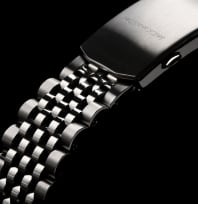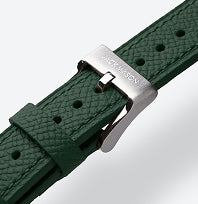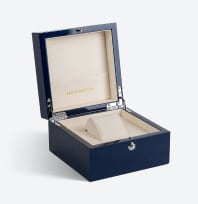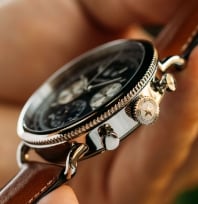Watches come in remarkably different sizes. Being able to properly measure your own watch can be a godsend, especially when examining vintage watches or evaluating what you aesthetically want from the next addition to your wrist. Style is not the only concern at hand: An improperly sized watch can cause discomfort and even nerve damage. Over the course of this article, we will show you how to easily measure any wristwatch you own in the comfort of your own home.
Why Measuring Your Watch Case is Essential
When purchasing a shirt, you would do more than simply look at it before making your purchase. Why, then, should watches be examined under a lesser degree of scrutiny? At Jack Mason, we understand that even the smallest details matter. Every single measurement of a watch is interrelated, affecting the overall size and appearance of the piece, which creates a distinct mark on your outfit and impression.
Oftentimes, companies will list the dimensions of their offerings online. In practice, the listed dimensions may not always be perfectly accurate, or some important measurements such as thickness may be omitted. For these reasons and more, it is highly important that you be able to take the measurements of your watch yourself.
Depending on how a watch was acquired and where it is from, accurate information on dimensions may not be available. In their early history, watches tended to be smaller, and many vintage watches have since undergone changes in design relating to size upon reissue. Furthermore, it is possible for the features or embellishments of a watch to obscure the true size of the case.
The most common factor at play is the bezel. A watch with a thick bezel but a comparatively small dial will appear to have a smaller case than a watch with more proportionate features. However, in reality, the bezel can significantly add to the diameter of a case, which then adds to the thickness of the overall piece.
Watch Size and Style
It should be noted that watches do not demand as perfect a fit as, say, a pair of shoes. A wrist can fit a range of sizes, allowing you to choose what you wear to make a statement matching your personal style. This is not to say that your choice in size should not be deliberate. Generally, men’s sizes start at around 34mm, though women’s watches and many vintage watches may run smaller. Tool watches such as dive watches tend to have larger case sizes to accommodate their extra features.
Additionally, for both men and women, large watches are becoming more popular. A large watch case may look great on your wrist under many conditions, but too thick a watch may cause your shirt or suit sleeves to bulge uncomfortably. On the other hand, too tight a watch may pinch or damage your wrist.
How To Measure Your Watch Case
A caliper will be needed for the measurements below, with one exception. A ruler may work in a pinch, but a caliper, ideally a digital one, will be the best tool for giving you the precise measurements needed. All measurements will be listed in millimeters, as that is the most commonly used metric for sizing. We will be covering the following topics:
- How To Use Your Caliper
- Measuring the Case of a Watch
- How to Measure Lug Width
- How To Measure Lug-to-Lug
- Measuring Thickness
How To Use your Caliper
Because using a caliper is slightly more complicated than using a ruler, we will be briefly explaining how to use it. If you already know how to use one, feel free to skip to the next section, “Measuring the Case.”
Due to their accuracy and ease of legibility, the following description assumes that a digital caliper is being used. A caliper consists of a beam and a movable plastic or metal attachment, which assists in taking measurements and reading the scale. On one side of the caliper is a set of exterior-facing jaws meant to take measurements such as length and diameter. On the other side is a set of interior-facing jaws, meant for taking inside measurements such as the distance between the lugs of a watch.
One half of each set of jaws is connected to the beam, and the other half is connected to the movable attachment. On the attachment is a thumbscrew, which adjusts the jaws of the caliper. There is also a lock screw, which holds the jaws in place. Digital calipers have additional features such as a battery compartment and an ABS button that resets the digital measurement to zero, as well as a button that switches the measurement between inches and millimeters.
To take an interior measurement, loosen the lock screw, place the exterior-facing jaws in the space you are measuring, and adjust until the upper jaws touch the wall of the hole. Then, tighten the lock screw. Remove when finished.
To take an exterior measurement, follow a similar pattern. Instead clamp the interior-facing jaws around the facet of the watch you are measuring.
Measuring the Case of a Watch
To measure the diameter of your watch, place the interior-facing jaws of the caliper on two opposite ends of the timepiece, making sure to measure across the center of the watch. Always be gentle, so you don’t scratch your timepiece. You should endeavor, if possible, to take your reading from the three o’clock to nine o’clock position. If your watch has a crown or other feature preventing an accurate measurement from these positions, you can elect instead to take your reading slightly offset from them, such as two o’clock to eight o’clock or four o’clock to ten o’clock.
For watches that are not perfectly round, you should attempt to take a measurement, still crossing the center of the watch, where the diameter will be the smallest. While this is an imperfect solution, it is the most accurate one to gauge how it will lay on your wrist. Once you have the calipers properly placed, you can take a reading in millimeters to find the case size. For the most proportionate look, try the following case sizes based on the size of your wrist:
- Six inches: On the smaller end. Try 34mm-38 mm cases.
- Seven inches: Medium-sized. 39mm-42mm cases will work best.
- Eight inches: For individuals with large wrists, cases between 44mm and 47mm will give the most proportionate appearance.
How To Measure Lug Width
Knowing how to measure the width between lugs is as important as knowing how to measure the case itself, as the lug width directly impacts the width of the strap you need to fit your timepiece.
Place one exterior-facing caliper on each lug, and make sure that you are measuring from the inner side of the lug and not the outer. Only the inner lug measurement determines the ideal strap width.
How To Measure Lug-to-Lug Distance
Not to be confused with the lug width, lug-to-lug distance refers to the distance between the lugs on the opposite sides of a watch. This measurement affects how a watch will lay across your wrist, which is essential information. With your caliper, use the interior-facing jaws to measure the distance between two parallel lugs on opposite sides of the watch. This measurement, taken with your wrist size, will let you know how comfortably it will sit on your wrist.
Measuring Thickness
Thickness is a less measured, though no less important dimension of a watch. All previous measurements and features we have alluded to, which is to say the bezel, case size, and lug width, have an impact on watch thickness. Generally, a larger case size means a thicker watch. For individuals with especially slender wrists, a thicker watch may cause discomfort when worn with proportionate dress clothes. However, larger watches often come with more special features than their smaller predecessors.
For example, the Jack Mason Solar Watch is made from recycled material, features solar-powered movement, and is tested for water resistance for up to 100 meters. Thickness is the one metric where simplicity works best: Lay your watch flat and gently push a ruler, standing up against it. Avoid using a caliper, as in order to measure with it, you would have to clamp the jaws onto the crystal itself. Watch thicknesses vary less than case sizes, with most being between seven and nine millimeters.
After Measuring
Whether you have now measured every watch in your collection, wanted to prepare for future endeavors, or were simply curious about the topics of this article, you are now one step closer to being in complete control of your wardrobe. A word of advice: Every rule has exceptions.
While the measuring guide should be taken as written, you know your own body and style better than anyone. Suppose you have a smaller wrist but want to show off a watch with an impressive case, or have a larger wrist but enjoy the look and feel of a smaller, sleeker design. In that case, we at Jack Mason encourage you to follow your true self and carry an extensive selection of watches to help you find them.
Sources:
How To Measure A Watch Case Size Easily [GUIDE] | The Slender Wrist
Radial Nerve Dysfunction | MedlinePlus
Digital Calipers: Why You Need This Tool in Your Collection | Family Handy Man












